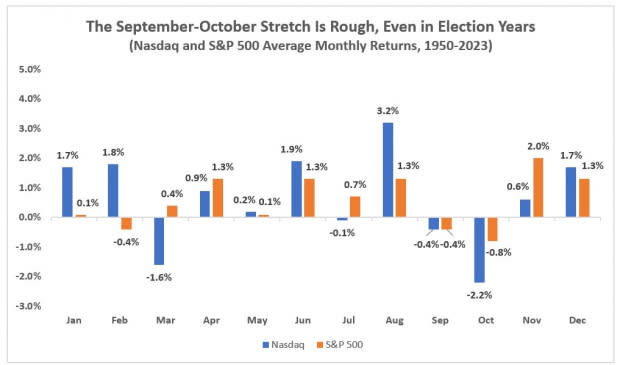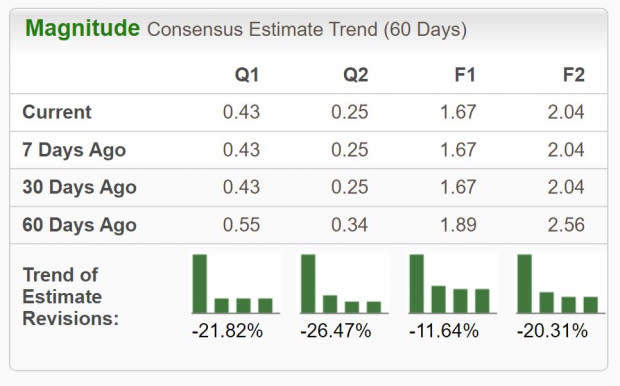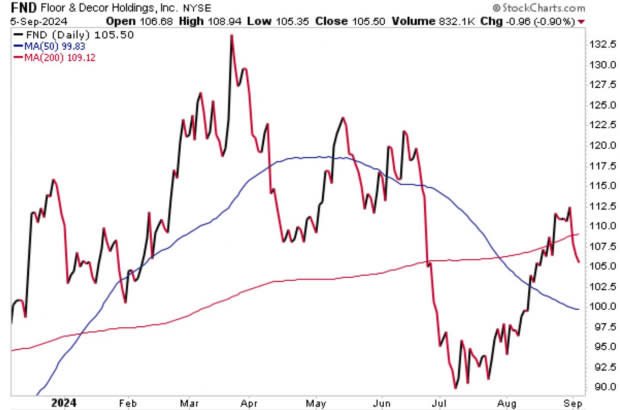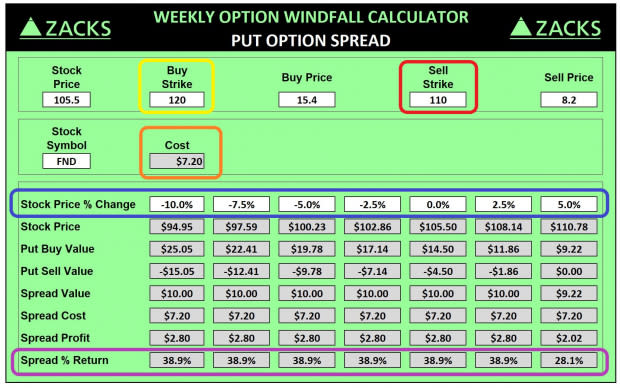Weekly Option Windfall: Retailer Downtrend Sets Up Bearish Put Option Trade
The major US indices have been met with a September swoon. Markets are now entering a seasonally weak period, which has shifted the investment landscape and resulted in a pronounced rotation. We’ve begun to see defensive sectors like consumer staples outperform, which can serve as a cautionary signal of an impending correction.
From one lens, a broadening out of this bull market is what we want to see. But on the flip side, if we start to see cyclical sectors like industrials roll over, it’s more indicative of that defensive leadership serving as a warning shot across the bow.
Recurring Seasonal Trends
The stock market tends to display seasonal propensities, whereby certain months of the year have historically outperformed relative to others. For example, we know that a positive tendency is usually exhibited around the holidays, particularly during the November-December stretch.
The month of September is widely known as the weakest month of the year. In terms of S&P 500 returns dating back to 1925, it’s the only month that has been net negative over time. The fact remains that September has been positive less often relative to any other calendar month.
October is also known for its volatile swings. In fact, we’ve seen a deep correction in the September-October period in each of the last two years. September has also been lower in each of the last four years.
We can see below that the odds simply aren’t with us. To make matters worse, election years that experienced a negative April and positive May (such as this one) tend to follow the typical September-October weakness.

Image Source: Zacks Investment Research
Option Essentials
With this bearish seasonal setup in mind, we are going to review a put option spread trade. But before we analyze today’s example, let’s review some option fundamentals as a refresher. There is no need to worry about complex mathematical formulas or equations.
Over the years I’ve found that the more complicated a strategy is, the less likely it is to work over the long run.
Options are standardized contracts that give the buyer the right – but not the obligation – to buy or sell the underlying stock at a fixed price, which is known as the strike price. A call option gives the buyer the right to buy a particular security, while a put option gives the buyer the right to sell the same. The investor who purchases an option, whether a put or call, is the option buyer, while the investor who sells a put or call is the seller or writer.
These contracts are valid for a specific period of time which ends on expiration day. There are weekly options, monthly options, and even LEAPS options which are longer-term options that have an expiration date of greater than one year.
Options consist of time value and intrinsic value. In-the-money options consist of both components; at-the-money and out-of-the-money options consist only of time value. At options expiration, options lose all time value.
Below we’re going to explore a put option spread strategy.
Profit From Floor & Decor’s Decline
Floor & Decor FND is a good candidate for our put option spread strategy. FND is a Zacks Rank #5 (Strong Sell) stock. Shares are widely overvalued based on traditional metrics and are trading at 63.8 times forward earnings. As we can see below, earnings estimates are on the decline, with analysts slashing current-quarter forecasts by 21.82% in the past 60 days:

Image Source: Zacks Investment Research
The Q3 EPS projection of $0.43 per share would translate to a -29.5% decline relative to the same quarter last year. Meanwhile, technical analysis of the stock’s price movement reveals a bearish head-and-shoulders pattern that formed earlier this year. The stock was recently rejected at key technical levels, setting up a resumption of the downward trend:

Image Source: StockCharts
Of course, we always need to be prepared for the other side of every trade. The great thing about option spreads is that they can profit even if the underlying stock moves in the opposite direction.
Put options are normally a better choice than shorting a stock outright. Shorting a stock has virtually unlimited loss potential if a stock continues to rally in price. Conversely, the maximum loss for a put option spread is limited to the purchase price.
The table below displays the risk/reward profile for this trade. Here we are purchasing the October 120-strike put (yellow box), and selling the October 110-strike put (red box). The purchase (debit) costs 15.4 points, while the sale (credit) costs 8.2 points for a total cost of 7.2 points. Since options account for 100 shares of the underlying stock, the total cost for this spread trade is $720 as we can see in the orange highlighted box.

Image Source: Zacks Investment Research
The top (blue) row shows the performance of FND stock based on different percentage scenarios at expiration. The bottom (purple) row shows the corresponding percentage return for our spread trade. We can see that if FND goes down, remains flat, or even increases by 2.5%, this trade will realize a 38.9% profit. If FND moves up 5% (goes against us as this is a put spread), we still would realize a 28.1% profit.
So, we are baking in some downside risk here in the event that Floor and Decor stock rises. These are the types of odds I like to have on my side when trading options.
Advantages of Option Spreads
1) Does Not Require Large Price Movement to Profit
Even if FND remains flat, we still enjoy a 39% profit in about a month.
2) Less Overall Risk
The put option sold profits when FND stock increases, providing us with a cushion. The sale of the 110-strike put reduced the risk of this trade from $1,540 to $720.
3) Allows Us to Maintain Positions During Volatile Markets
The downside protection provided from the put option sale helps us maintain our spread trade during periods of elevated volatility.
4) Introduces New Profit Dimension
There aren’t many times when we make money even when a trade goes against us. For this bearish put option spread, we can still profit even when FND stock increases in price.
Bottom Line
We know that the month of September is historically weak, and the heavy selling pressure to start the month could be indicative that seasonal trends may persist again this year.
Option spreads are a safe way to use the leverage inherent in options. During this time of economic uncertainty and swingy market action, it pays to implement a strategy that can take advantage. I think the FND trade example demonstrates why option spreads are an ideal investment!
Want the latest recommendations from Zacks Investment Research? Today, you can download 7 Best Stocks for the Next 30 Days. Click to get this free report
Floor & Decor Holdings, Inc. (FND) : Free Stock Analysis Report